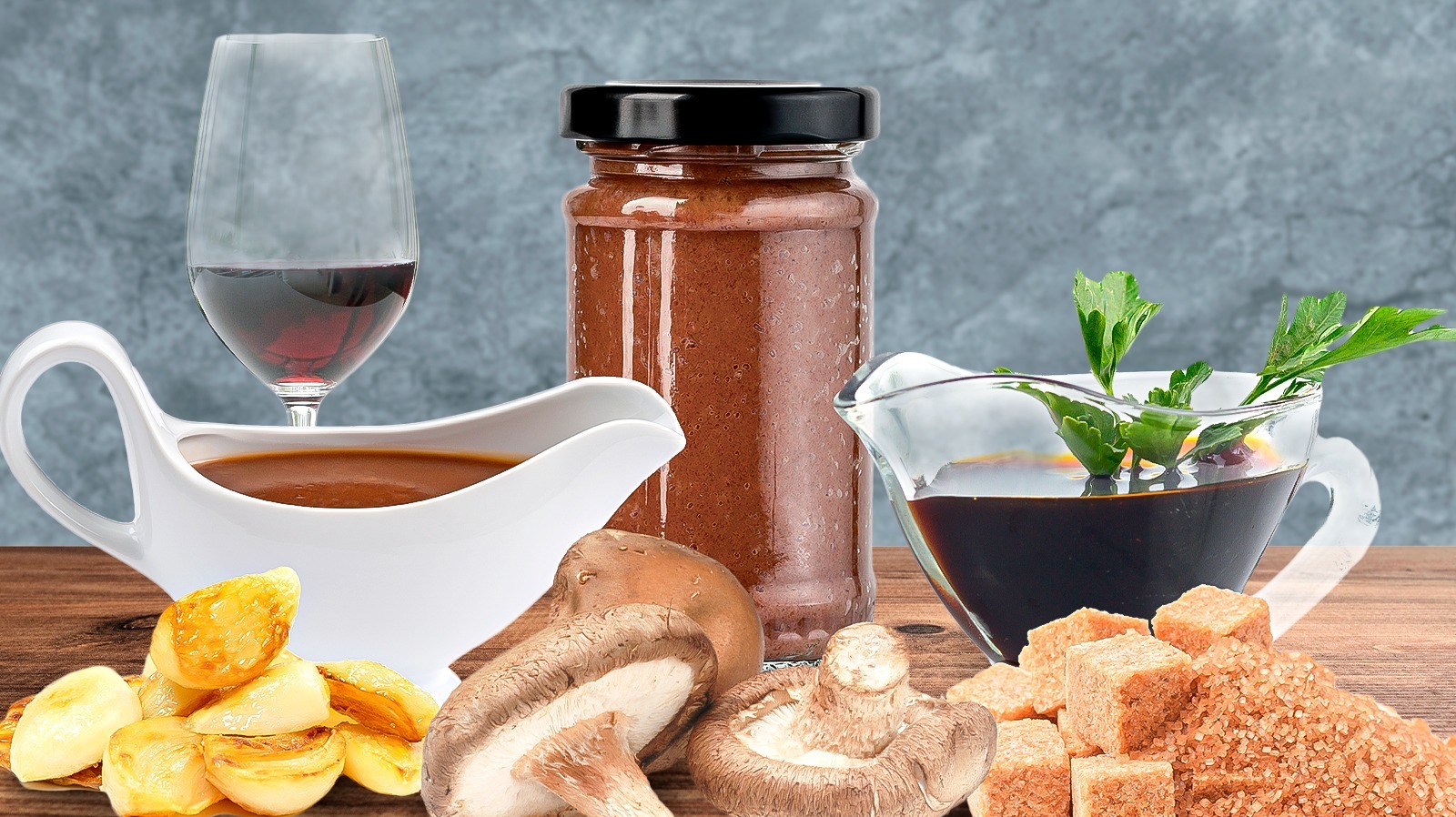Gravy is one of those sauces that isn’t always necessary, but it definitely makes a Thanksgiving turkey or holiday roast even better. It adds a decadence that just elevates the whole meal. While homemade gravy is almost always better than store-bought varieties, sometimes we just don’t have the time to make a thick, rich gravy.
It’s during these times that we’ll grab a packet of powder from the selection available at the store, and take it home to whip up a simple, easy gravy that ties the whole meal together. There’s just one problem: most of those powder-based gravies are either bland or thin or simply lack that extra kick of flavor we get when gravy is made from scratch. But that only holds true if you strictly follow the directions on the packet, or don’t bother adding any flavor enhancers to pre-made gravy sold in jars.
While it’s easy to simply add water or stock to gravy powder and have a sufficiently fine sauce to serve with your favorite protein, it’s just as easy to add an extra ingredient or two and turn that plain gravy into something really special. Something you’d love to slather all over your meat and potatoes. Something that no one would ever realize isn’t homemade. The only question is, what is that extra ingredient? Turns out there isn’t just one. We have 12 different ways to take your store-bought gravy from boring to amazing in a matter of minutes.
Add flavorful brown butter
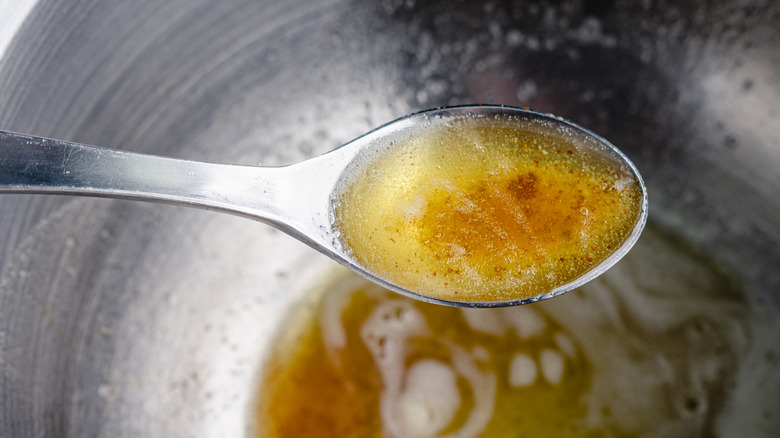
Although it will take a little time to prepare this ingredient before adding it to store-bought gravy, it’s well worth it. Brown butter can elevate many recipes because it provides a richness that just can’t be achieved with ordinary butter. You can’t do this by simply melting butter in the microwave, though. No, in order to make brown butter, you’ll need a pan and low heat. Then the magic happens. Not only will browning the butter fill your kitchen with those wonderful baking smells we all crave, but it also gives foods a nuttiness that can’t be beat.
The complex flavor that comes from brown butter is due to the Maillard reaction, which occurs after the butter’s water evaporates and its proteins and sugars start integrating to form new flavors. This interaction will be made apparent when brown specks become visible in the melted butter, as those specks are separated milk solids toasting into deliciousness, imbuing the liquid with a rich, nutty flavor that will enhance your gravy. Once those solids start browning, don’t leave the pan — use the stirring secret to even more flavorful brown butter. It only takes a minute for your brown butter to become burned butter, and no one likes that flavor … in any recipe.
Swirl some cognac into the mix

Pouring in a splash of liquor is the boozy way to elevate store-bought gravy, and there are many tipples to choose from that will work well. However, cognac tends to have essences of leather, citrus, and vanilla that add an earthiness to gravy, tempering the saltiness that can sometimes be found in a jarred version.
But don’t worry, just because you’re adding liquor to the gravy, that doesn’t mean you’ll feel tipsy after consuming your meal. By combining the cognac and gravy in a pan and letting it simmer for several minutes over low heat, you’ll be cooking off any of the mind-bending effects the liquor would normally have when imbibed on its own. However, you’ll be infusing the gravy with some wonderful flavors at the same time.
If you happen to buy a creamier gravy, cognac is an even better addition, because it will cut through that richness and make the gravy lighter while still maintaining all that hearty lusciousness.
Savory drippings will elevate gravy

If you’re roasting a turkey, the drippings that lurk in the bottom of the pan are a beneficial addition for that store-bought gravy, as they will add a ton of flavor. You may think drippings are only melted fat, but they also contain plenty of little roasted turkey pieces, as well. Each one of those small browned bits holds a pop of savory goodness that will only add more depth to your gravy, especially when left to simmer for several minutes over a low flame.
Not sure how to get all that yumminess into that shelf-stable jar? It’s really very easy: Simply transfer the roasted turkey to a platter, pour the liquefied fat from the roasting pan, and then place the pan over a low flame to deglaze it with your favorite wine or chicken stock, all the while scraping the bottom of the pan with a wooden spoon. After you save those pan drippings, stir them into your store-bought gravy, and voilà — you have delicious gravy that tastes like the product of spending hours over your hot stove.
Wine makes gravy taste divine

Giovanni Magdalinos/Getty Images
Many of us enjoy having a glass or two of wine with dinner — but wine is not just for drinking. It can make a great ingredient as well, and can be used in stuffings, dressings, salads, and even desserts. So, why not add it to your gravy?
Depending on the type of gravy that you’re pairing with the main course, you could add a white or red wine. White would be great with turkey or chicken, while rich red wine gravy would be a nice choice if you’re using it for red meat. You could even add rosé, if you like. But no matter which wine you choose, each will bring a different flavor to the gravy.
A chardonnay or sauvignon blanc might add a nice tart pop that would brighten up the gravy, while a cabernet or merlot would give the gravy a more hearty, wintery feel. Either way, you’ll end up with a gravy that’s more flavorful, and will have no one at your table questioning if you made it yourself.
Sprinkle in some herbs
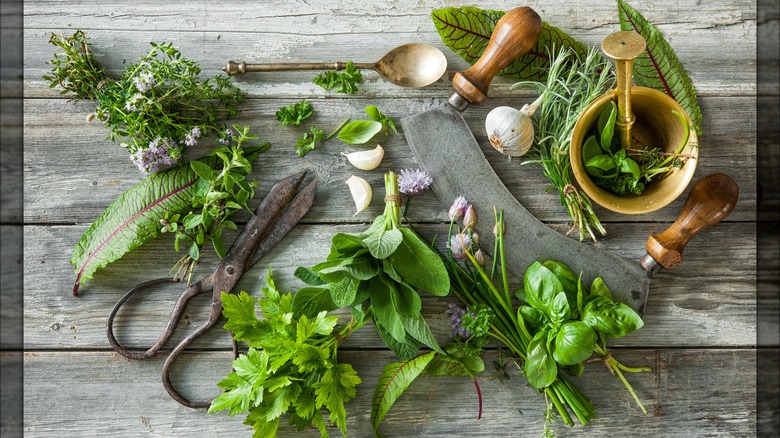
Herbs are an ingredient that you often don’t realize are needed until you taste a recipe without them, and notice something’s missing. With so many herbs to choose from, the final result can be anything from fresh and bright to subtle and spicy. Herbs can take a dish that’s just okay and turn it into something awe-inspiring without adding any extra sugar or fat. They’re probably one of the healthiest ingredients out there, and because they’re so versatile, herbs will work in almost any recipe you add them to (as long as you add the right ones). Want to brighten up your salad? Add some chopped parsley. Looking to add some floral notes to that bundt cake? A couple dashes of lavender will do the trick.
The same can be said about that store-bought gravy. Simply adding a teaspoon or two of chopped rosemary or sage can elevate gravy while adding an extra layer of depth. But if you’re going to add herbs, it’s best to do so in the last few minutes of cooking, since they tend to be so delicate. That way you’ll get the most flavor out of them.
Also be aware that dried herbs tend to be more potent than fresh herbs. But no matter which way you go, make sure to taste as you add. Too little, and you won’t notice any difference. Too much, and you’ll overpower your gravy.
Roasted garlic will give gravy pungency
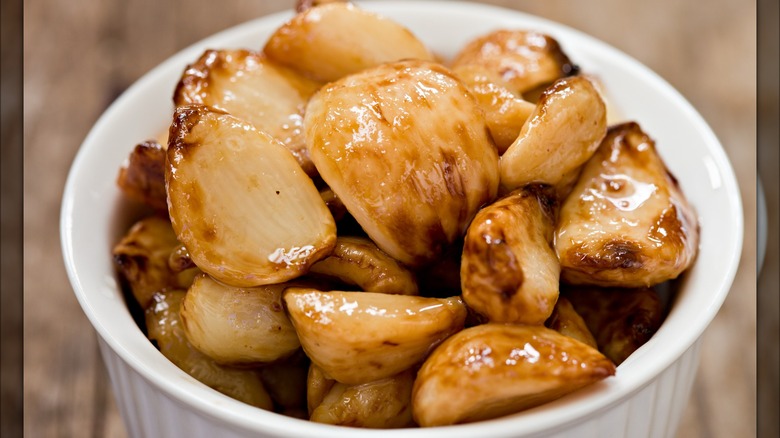
Garlic is a pantry staple. It’s often added to recipes for an extra pop of pungency. If eaten raw, you get a spicy punch to the palate. But if you roast the garlic with a drizzle of olive oil and salt, that spice mellows as the bulb’s natural sugars caramelize, and it turns into a sweet paste that’s wonderful when spread over warm baguettes or when making compound butter. It’s also the perfect way to improve upon that purchased jar of gravy sitting on your counter.
Simply incorporating a few cloves of roasted garlic will give store-bought gravy a homemade flavor, adding a sweet-yet-spicy note unlike anything else. Start with just two or three cloves, because while roasted garlic is mellower than its raw counterpart, it still has a distinct flavor, and you want to enhance the ready-made gravy, not overwhelm it. However, if you and your dinner mates love the taste of garlic, feel free to add a few more cloves for a garlicky gravy that’s sure to taste delightful.
Blend in the earthy essence of mushrooms
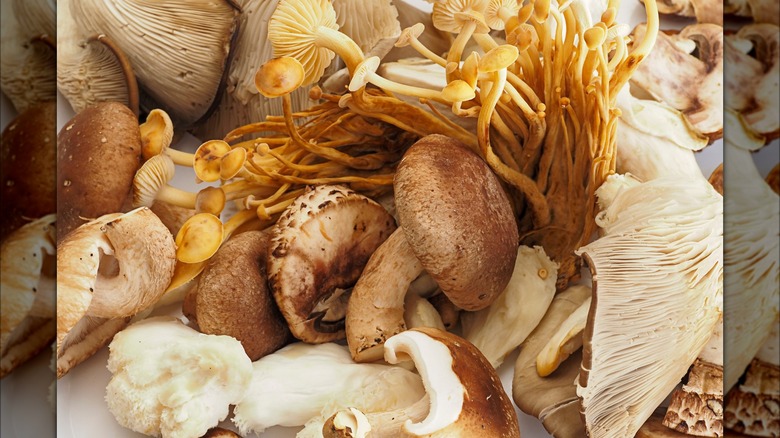
Mushrooms may be a fungus, but they’re a fungus that countless foodies can’t get enough of. With so many different types of mushrooms that each have their own distinct flavor, they add a heartiness to recipes that’s impossible to duplicate. Mushrooms can make a great main course, but they can also improve a dish by adding a rich, umami flavor. In this case, we’re using them to make that pre-made gravy much better.
From the popular button mushroom to the rich and meaty portobello, each mushroom has its own flavor — there are even some mushrooms that taste similar to lobster. Your choice of mushroom depends on what you’re in the mood for. In the case of a creamy gravy, you’ll want something that has plenty of meatiness to it, balancing out the gravy’s richness. While you could focus on one specific mushroom, if you want to create a really complex meat topper, it’s best to get a few different kinds and mix up your mushrooms for an earthier gravy. That way you’ll enjoy a symphony of flavor instead of the one-note gravy you originally purchased.
Incorporate a splash of vermouth

Vermouth may seem like an odd choice for gravy, as it’s often reserved for cocktails. But just like other types of alcohol, vermouth can also be used to enhance food recipes.
There are three different versions of vermouth: dry, sweet, and bianco, with the latter tending to fall somewhere between the first two varieties thanks to the varied botanicals used in its distillation. While you could use bianco in gravy, dry vermouth works well because it has an herbal, bitter flavor, which is why it’s used in dry martinis. Sweet vermouth, on the other hand, tends to have a rich, aromatic taste.
So, for a rich gravy that has subtle bitter notes, add a few tablespoons of dry vermouth. But if you’re in the mood for something slightly sweeter with notes of citrus, add the sweet vermouth. Either way, you’ll have a complex gravy that will be a wonderful complement to that roast chicken or turkey.
Gravy gets better with Worcestershire
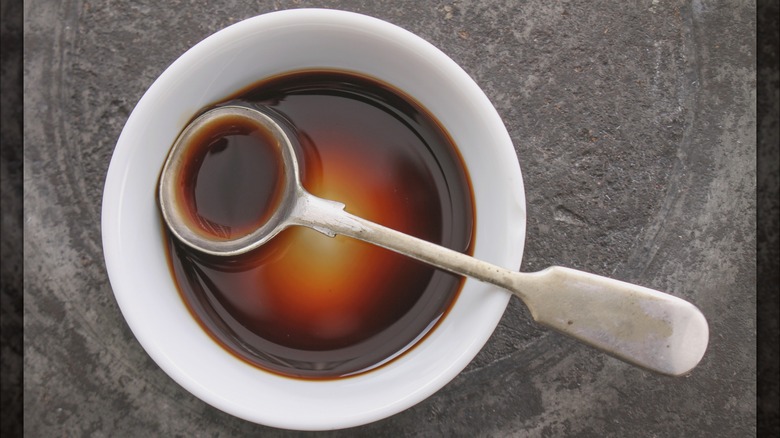
If you’re looking for a secret ingredient to give gravy an umami boost, a couple tablespoons of Worcestershire sauce is the way to go. Often added to dips, sauces, and any good bloody mary, Worcestershire has a strong, savory flavor thanks to its intricate recipe featuring anchovies, vinegar, tamarind, sugar, spices, garlic, and molasses. This wide range of ingredients hits every part of the tongue. The saltiness of the anchovies pairs well with savory roasts and chicken, while the tart pops of vinegar and tamarind will enhance any citrus essences. Meanwhile, the sugar and molasses will compliment the savoriness of your store-bought gravy.
As with all other additions, the key to enhancing pre-made gravy is mixing it in and letting it simmer for a few minutes before serving. That way you’re guaranteed that the indescribable Worcestershire flavor we can’t get enough of will meld with the rest of the gravy, creating a finished sauce that’s so outstanding, only you will know your gravy isn’t homemade.
Spice it up with chili powder
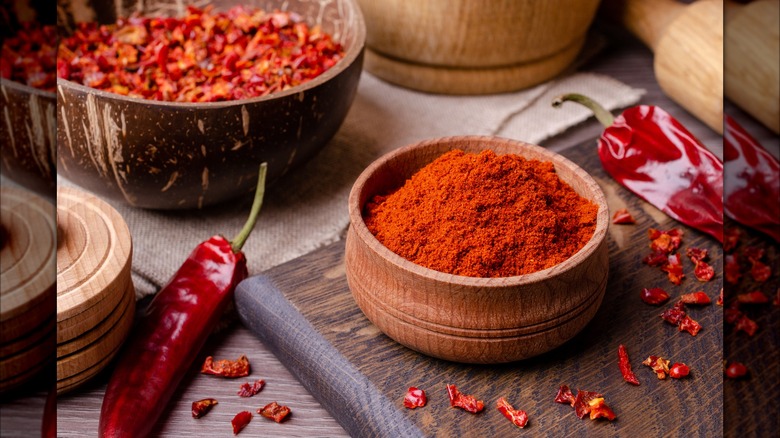
Prefer a spicier meal? Then adding a little chili powder might be just the thing to make that store-bought gravy absolutely perfect. What we really love about chili powder is its versatility. Sure, it’ll add bite to your gravy, but how serious that bite is will be totally up to you.
If you prefer just a touch of heat, a teaspoon stirred into the gravy as it simmers will be enough to wake up your senses. But if you prefer tongue-numbing spiciness, then a couple tablespoons will do the trick.
Of course, that much chili powder won’t just cause your tear ducts to overflow, it will also totally change the flavor of the gravy itself. Remember that the longer the spice simmers, the more it permeates into the liquid, and the spicier your gravy becomes. So, we’d recommend adding a pinch at a time until you find the perfect balance — enough to make your taste buds stand at attention, but not enough to overpower the rich heartiness of the gravy itself.
Make gravy silky with cream
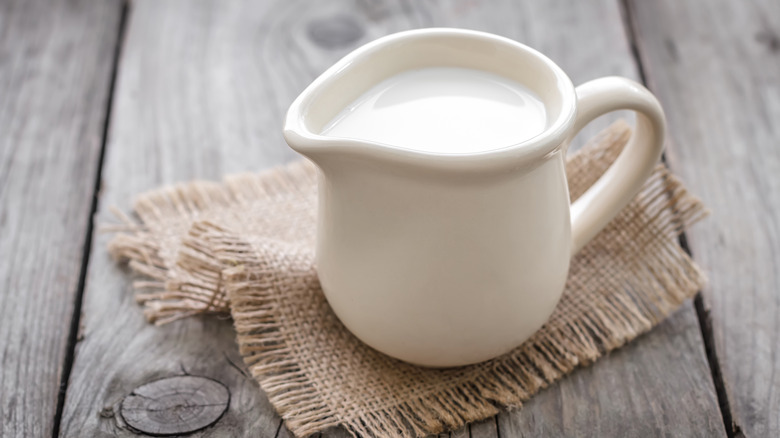
There’s nothing better than a thick, rich, creamy gravy. The way it coats that turkey breast or slice of roast beef is pure art. And when you see that silky-smooth stream spread like satin over your protein, you know it’s going to do the same over your tongue.
Unfortunately, most store-bought gravy lacks that rich mouthfeel, because most use stock or water that creates a thinner texture that doesn’t really coat anything. But just because the manufacturer decided what liquid is best for its gravy, you don’t have to settle for that. Once that jar or packet is in your house, you’re free to do with it what you will, and there’s no better choice than adding a healthy pour of the thickest cream you can find.
Now, we know that cream has gotten a bad rap in the past because of its fat content. But it turns out that cream also has a significant amount of vitamin B2, which promotes the growth of new healthy tissue. So, that creamy gravy won’t just taste good, it could improve your health. But if you’re still uncomfortable with using heavy cream, something a little lighter — like half-and-half or whole milk — will work just as well, and still turn that store-bought gravy into a creamy, decadent sauce.
Squeeze in some lemon juice
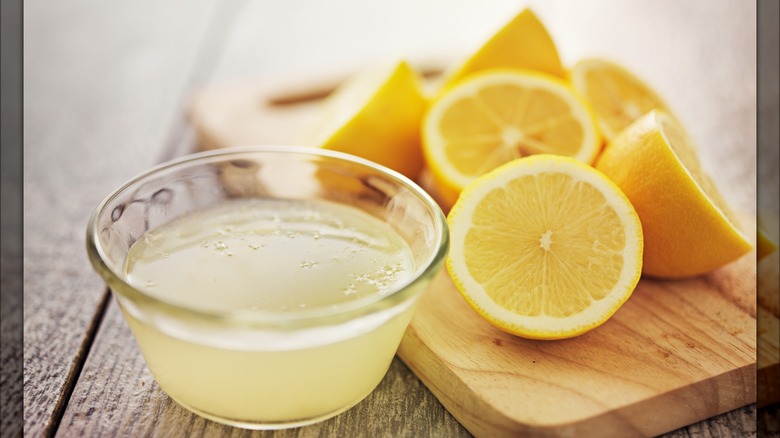
Since sour is a flavor specifically singled out by our tongue’s taste receptors, chefs often try to include it in savory recipes like marinades and sauces so that the final dish comes together in perfect harmony. Sour ingredients can take many forms, and of course that includes citrus juice. When you consider how many recipes have one sour ingredient or another included, it’s no surprise that a teaspoon or two of lemon juice will seriously upgrade your gravy.
Lemon juice may seem like an odd choice for gravy, but believe it or not, this will actually help balance out the other flavors in the sauce. Perhaps that jarred gravy is too salty. A tablespoon of lemon juice will cut through that salt, mellowing it and creating a gravy that’s more palatable. But it also cuts through the fat, turning that gravy into something light and bright.
If you choose to add a splash of lemon juice to your gravy, make sure it’s fresh. That little plastic lemon from the store is never a good choice. Who knows how long it may have been sitting on the shelf, which means it could have lost some of its punch — or worse, it might have gone bad. But if you cut and squeeze the lemons yourself, you’re in control of the final, delicious flavor.



